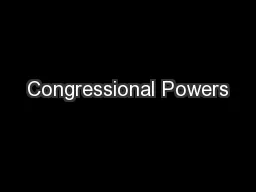

Congressional Power Congressional power is limited by the fact that it has only those powers delegated to it by the Constitution Congress cannot create national public schools Congress cannot require people to ID: 553065
Download Presentation The PPT/PDF document "Congressional Powers" is the property of its rightful owner. Permission is granted to download and print the materials on this web site for personal, non-commercial use only, and to display it on your personal computer provided you do not modify the materials and that you retain all copyright notices contained in the materials. By downloading content from our website, you accept the terms of this agreement.
Slide1
Congressional PowersSlide2
Congressional Power— Congressional power is limited by the fact that it has only those powers
delegated
to it by the Constitution.
Congress cannot create national public schools.Congress cannot require people to vote.Congress cannot create a national religion.Congress cannot censor the content of newspapers or other media outlets.Congress cannot abolish jury trials.Expressed Powers—specifically mentioned in the Constitution.Implied Powers—based on reasonable deduction.Inherent Powers—based on the creation of a sovereign government in the world community.
Congressional PowersSlide3
Strict
Constructionists—Led by
Thomas Jefferson
. Believed that Congress should only be able to exercise the expressed powers and the implied powers that are absolutely necessary to performing their duties.Liberal Constructionists—Led by Alexander Hamilton. Favored a liberal interpretation of the Constitution. Over the years, the power of the National Government has grown substantially with the support of the American people.Liberal Constructionists have won out over time due to wars, economic crises, national emergencies, improvements in transportation and communication, and demands by the people for more government services.Strict vs. Liberal ConstructionSlide4
Power
to Tax—a charge levied by the government on persons or property
Taxes are used to meet
public needs.Taxes (tariffs) are used to protect domestic industry.Taxes protect health and safety (licensing drug companies).Limits on taxationCannot tax churchesCannot impose poll taxesTaxes must be for public purposes, not private benefitCannot tax exports
Peacetime Expressed
PowersSlide5
Borrowing Power
Article I, Section 8, Clause 2 of the Constitution gives the federal government the ability to borrow money on the credit
of the United States.
There are no limits on the amount that we can borrow which has allowed the government to deficit spend.Public Debt—is all of the money that has been borrowed over the years that has not been repaid.http://www.usdebtclock.org/Peacetime Expressed Powers (cont’d.)Slide6
Commerce Power
Represents the power of the federal government to regulate foreign and interstate commerce
.
Gibbons v. Ogden, 1824—was the 1st major court case regarding the Commerce Clause to reach the Supreme Court. Read page 297 and explain this case below:The Supreme Court ruled in favor of Gibbons and the federal government.Over the years, the Commerce Clause has been interpreted more widely and applied to issues such as the minimum wage and the Civil Rights Act of 1965.Limits on commerce power.Cannot tax exports.Cannot favor the ports of one state over another.Peacetime Expressed Powers (cont’d.)Slide7
Currency and Bankruptcy Power
The Constitution gives Congress the authority to establish a single/common legal tender
.
Article 1, Section 8, Clause 4 gives Congress the ability to establish uniform policies for bankruptcy. It is a concurrent power.https://www.youtube.com/watch?v=HuGIgf-ICHMPeacetime Expressed Powers (cont’d.)Slide8
To
declare warTo raise and support
armies
To provide and maintain a navyTo make laws governing land and naval forcesTo summon, organize, arm, and discipline the militiaWar Powers (Expressed)Slide9Slide10
Given
to Congress through the Necessary and Proper Clause or the “
Elastic
Clause”The Supreme Court gave its approval to this concept in the court case McCulloch v. Maryland, 1819.Complete the chart below explaining the implied powers given by the each expressed power (page 308):The Implied PowersSlide11
Lay and Collect Taxes
Raise Armies and a Navy
Regulate Commerce
Borrow Money
Establish Naturalization Law
Establish Post Offices
-
punish tax evaders
-regulate or outlaw sale of some commodities
-set standards for states to gain fed funding
-the draft
-minimum wage
-ban discrimination at work and public facilities
-disability protection
-regulate banks
-establish the Federal Reserve Banking System
-regulate and limit immigration
-prohibit mail fraud and obstruction
-ban some items from being mailedSlide12
Nonlegislative
Powers
Amendments—
Article V allows Congress to propose an Amendment by 2/3 vote in each houseElectoral Duties—House will choose a President by state if no majority in the electoral college / Senate will choose a VP by senatorImpeachment—House is Grand Jury / Senate is Trial JuryExecutive Appointments and Treaties—Appointments must be approved by majority of the Senate / Senate Foreign Relations Committee is now very influential on treatiesInvestigation—gather info for a bill, oversee executive operations, bring attention to a particular topic (steroids in baseball), expose public officials, promote interests of some members of Congress